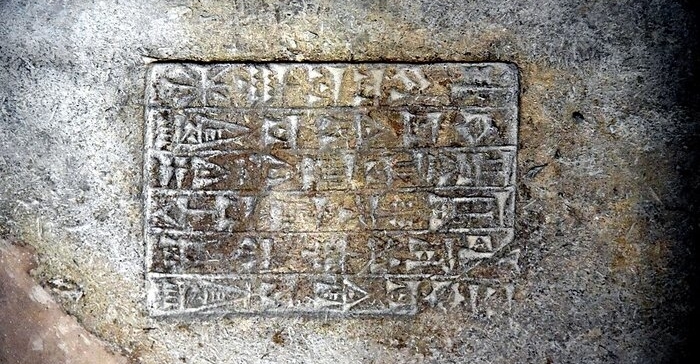A NOTE ABOUT DATES
by Roger Wyatt | 27th February 2021 | more posts on
'Chronology and the Bible'| 0

Photograph: Detail. Fired mudbrick, stamped. The cuneiform inscription mentions the name and titles of Nebuchadnezzar II, king of Babylon. From Babylon, Iraq. British Museum - By Osama Shukir Muhammed Amin FRCP(Glasg) - Own work, CC BY-SA 4.0, https://commons.wikimedia.org/w/index.php?curid=95962898
A note about dates in the late monarchic period of Judah
There was no absolute chronology in the ancient world and most ancient kingdoms like those of the Neo-Assyrians and Neo-Babylonians simply recorded the year of a king’s reign in their chronicles – in fact, the Neo-Assyrians used the successive number of the king’s annual campaign (palû) – which, it turns out, were not always annual. Similarly, in the kingdoms of Israel and Judah, the year was measured by the regnal year of the king, and in the books of Kings and Chronicles, these were held up against one another, thus providing a relative chronology - albeit a chronology that needs much work to unravel. For example, in the days when both kingdoms were still in existence, the date of accession of a king of Israel was compared with the year of the reign of the contemporary king of Judah as exemplified in 2 Kings 15:13: ‘Shallum son of Jabesh became king in the thirty-ninth year of Uzziah king of Judah, and he reigned in Samaria one month’. The relative nature of such chronologies makes it a far from straightforward task to calculate any dates in the ancient world, and even those that are considered established, have margins of error.
During the period under scrutiny, two different dating systems were in place, post-dating and ante-dating (accession and non-accession). The Babylonian kings and the kings of Judah used a post-dating system:
‘in the postdating system, years can be counted from one New Year's Day to the next, with Year 1 beginning on the first New Year's Day after the accession. The time from accession to the first New Year's Day is the accession year. This system was standard in Babylonia at the time of Cyrus' conquest in 539 B.C.E.’
The Neo-Babylonian new year (rêš šattim lit. beginning of the year) started in the spring, in the month of Nisannu (the Hebrew Nisan). So, by way of example, if a Babylonian king came to the throne in the summer, his first year would not begin until the following spring, and the intervening period was his ‘accession year’ – Nebuchadnezzar’s accession year was 605 and his first year was 604. In contrast, antedating or predating was used in Egypt by the Saite dynasty (Nebuchadnezzar’s contemporaries) and is the reverse of the above; a king’s first year was dated from the preceding new year – in fact it is more nuanced. In ancient Egypt, the new year was marked by the annual rising of the Nile and the appearance of Sirius, the brightest star in the sky, in around July. In fact, the accession year of an Egyptian king began from his accession, to the beginning of the Babylonian new year, and his first year ran from then until the beginning of the following Egyptian year (not a full year).
The last kings of Judah also used a postdating (accession) system, and the first regnal year of a king began on the first Tishri after their accession. The regnal year of the king, therefore, ran from autumn to the following autumn, Rosh Hashanah (lit. head of the year), falling on the first day of Tishri. The kings of Judah also allowed for an accession year, and can be illustrated by a consideration of the short reign of Jehoiachin. 2 Chronicles 36:9 records that ‘Jehoiachin was eighteen years old when he became king, and he reigned in Jerusalem three months and ten days’. Fortuitously, Babylonian hard inscriptions also document the attack on the city of Jerusalem in which Jehoiachin was taken prisoner and exiled:
‘[Rev.11'] In the seventh year, the month of Kislîmu, the king of Akkad mustered his troops, marched to the Hatti-land,
[Rev.12'] and besieged the city of Judah and on the second day of the month of Addaru he seized the city and captured the king.’
The two historical records, when considered together, reveal that Jehoiachin must have begun his accession year around the 20th of Chesvan (Marheshvan) and that his reign ended on or near the 2nd of Adar; Jehoiachin therefore never even reached Tishri to begin his first regnal year, and yet he was still said to have had a reign.
Of course, the reckoning of the regnal year from different starting points in the year also adds confusion to the process of establishing a sound chronology of the period. As a case in point, any attempt to synchronise the reigns of the king of Babylon and the kings of Judah must take into account that there is a sixth month difference between the start of the two regnal years – the kings of Judah commencing their regnal year in Tishri, and those of Babylon in Nisan. This can create particular chronological oddities when any effort is made to piece together events into an absolute chronology of the late monarchic period.
In many ways, the attempt to create an absolute chronology is an imposition on the past. In the ancient Near East, January was never understood to be the start of the year and chronologies were relative. In the kingdom of Judah there was the added confusion of marking the start of the religious year, which began in Nisan. Indeed, any attempt to synchronise the prophecies of Ezekiel with those of the chroniclers soon exposes Ezekiel’s belief that the year started in the spring. The pitfalls of building a sensible chronology then are many, although not impossible, and with all this in mind, as a rule of thumb, the regnal years of the kings of Judah (and Babylon), run across two years in an absolute chronology, and should be written with a dividing ‘/’, for example 586/585 would be the eleventh year in the reign of the last king of Judah, Zedekiah.
